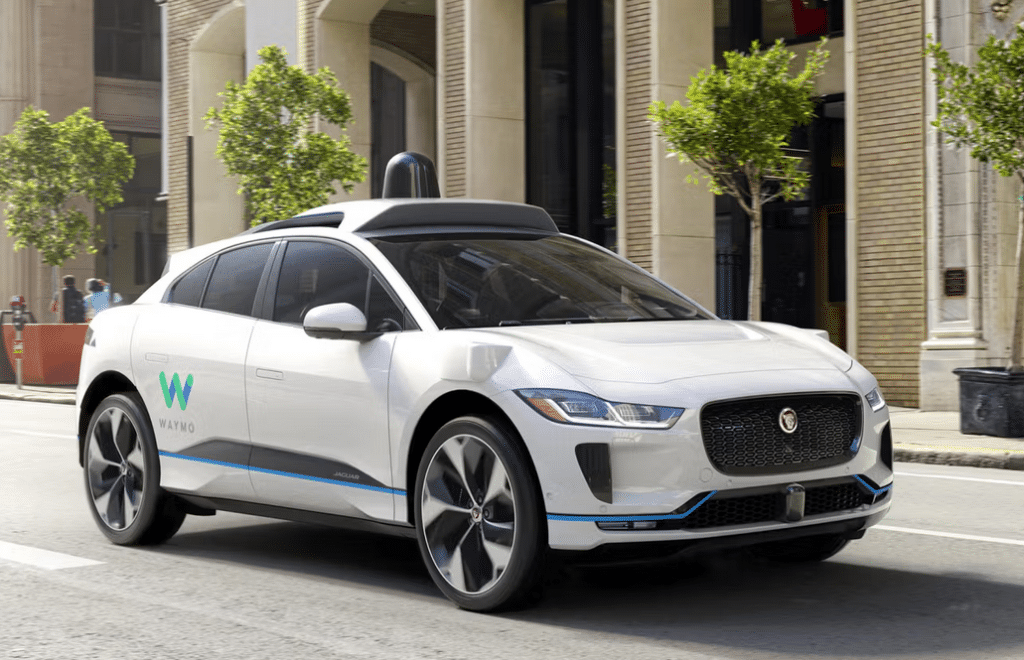Hot EV Topics for 2025
As 2025 approaches, what are the EV industry’s hottest new topics? While it’s hard to narrow them down with so many exciting things, we came up with Autonomous Vehicles, Wireless EV Charging, and Street Pole Charging.
Autonomous Vehicles (AVs) and Robotaxis
Waymo One is Waymo’s commercial autonomous ride-hailing service, offering rides in self-driving vehicles without the need for human drivers. The vehicles are also known as robotaxis. The service initially launched in the Phoenix, Arizona area and has since expanded to cities like San Francisco and Los Angeles. Waymo uses the fully-electric Jaguar I-PACE in Phoenix, Arizona, and the company is currently modifying Hyundai Ioniq 5 EV models to serve as robotaxis.
Waymo One is the safest self-driving technology available today. Using advanced sensor technology and artificial intelligence, Waymo One vehicles navigate urban environments safely and efficiently, handling diverse driving conditions.
The service is accessible through a mobile app, allowing users to book rides and monitor vehicle locations. It emphasizes safety, sustainability, and accessibility, often using electric vehicles to promote eco-friendly transport. Waymo One aims to provide a convenient alternative for daily commutes, errands, and general transportation, with its long-term goal being broader adoption and deployment of autonomous vehicle technology.

Wireless EV Charging (WEVC) Growing Fast
With the rise of AVs and robotaxis, the most efficient way for these vehicles to charge is to charge wirelessly, without human intervention.
Wireless EV Charging (WEVC) has been around for a while. WiTricity, one of the earliest WEVC companies, was founded in 2007 in Massachusetts as an MIT spinoff. The rise of AVs and robotaxis has sparked a new interest in WEVC and is expected to be the EV charging method of the future.
WEVC Basics
Interest in WEVC is growing, and for good reason. WEVC operates through inductive charging, where energy is transferred from a charging pad to a receiver pad, typically on the bottom of the vehicle. When a car, truck or bus travels, parks or stops over the charging pad the process starts automatically. Within seconds, energy begins flowing to the vehicle without any physical connections or additional steps required. Wireless systems now achieve power transfer efficiencies on par with traditional plugged charging, both reaching around 90%.
One wireless charging approach, called “opportunity charging,” integrates charging into electric public transportation buses. When the buses make their stops, opportunity charging occurs through WEVC while the bus is stopped, waiting for passengers to get on or off the bus. This allows the buses to use smaller batteries, which saves costs, among other benefits.
Another innovative approach being developed is above-the-vehicle wireless charging, with the ability to support multi-vehicle charging utilizing a single setup. Using an overhead gantry, the system can traverse multiple parking spaces, sequentially aligning the transmitting coil with each vehicle’s receiving coil for Level 2 charging.
In-road, “dynamic EV charging,” is another WEVC method in which the inductive coils are installed into roads, so that an EV may charge while driving along the WEVC-enabled road. Several pilot projects are under way in the US. One of those is UCLA’s collaboration with wireless charging company Electreon and nonprofit Calstart at its campus in Los Angeles. UCLA is installing coils into the road surrounding the university for dynamic charging, as well as at bus stops for opportunity charging.

Street Pole Charging, an Important Innovation for Multifamily EV Drivers
At nearly a third of the US population, multifamily dwellers are struggling with EV adoption. There are multiple reasons for this, including needing HOA approval, the high costs involved, and competing priorities among property owners.
Mounting EV chargers on existing utility or light poles is a transformative approach to urban EV charging infrastructure, offering a practical and cost-effective solution for cities grappling with the challenges of space, cost, and accessibility. By utilizing existing infrastructure, this method significantly reduces installation costs—by as much as 70%—compared to traditional ground-based chargers. The need for additional construction is minimized, streamlining deployment and making the process both faster and more affordable.
This approach is particularly suited to densely populated urban areas where space is limited, and conventional charging stations are often impractical. Pole-mounted chargers blend seamlessly into the streetscape, reducing visual clutter while preserving valuable curbside and pedestrian spaces. Typically positioned ten feet above ground, they are naturally protected from vandalism, vehicular accidents, and environmental wear, ensuring durability and lower maintenance costs over time.
Functionally, these Level 2 chargers deliver up to 35 miles of range per hour of charging, making them an ideal option for EV drivers parking for extended periods, such as overnight near apartments or during visits to shopping or dining districts. This setup is especially beneficial for multifamily residents without access to home charging solutions.

Electric Vehicle Marketing Consultant, Writer and Editor. Publisher EVinfo.net.
Services